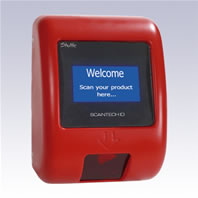|
| Power supply voltage |
100-240 Vac 50/60 Hz or Power over Ethernet IEEE 802.3af (optional) |
|
| Power consumption |
3 -5 Watt (5.2Vdc, 580-950 mA). Depending on interface and scanner type. |
|
|
| Interfaces |
Standard Ethernet or 802.11b WiFi (optional) |
|
|
| Light source |
Visible laser diode (630 – 670 nm) or red led |
|
| Depth of field |
200 mm (= maximum reading distance) |
|
| Scan pattern |
Omnidirectional or single line |
|
| Bar code types |
Code 128, EAN 128, Code 39 (+ full ASCII), Code 32, Code 93, MSI/Plessey, Codabar, Interleaved 2/5 |
|
|
| Dimensions |
183 (h) x 132 (w) x 95 (d) mm |
|
| Display |
High-bright blue-white 128x64 pixels |
|
|
|
| Operating temperature |
0°C … 40°C |
|
| Humidity |
20% .. 95% RH (non condensing) |
|
|
| Laser Safety Electrical Safety EMC |
IEC 825-1 (1993) Class I, U.S. 21CFR1040 Class IIa |
|
|
EN 60950 (1992), IEC 950 (1991), UL1950 3rd edition, |
|
|
|
EN 61000-6-3 (2001) Generic emission standard, from which: |
|
|
EN55011 (1998) Emission –Class B |
|
|
EN 61000-6-2 (2001) Generic immunity standard, from which: |
|
|
EN 61000-4-2 (1995) Electrostatic Discharge (ESD) immunity, |
|
|
EN61000-4-3 (1996) Radiated Electro-Magnetic field immunity, |
|
|
ENV 50204 (1995) Digital radio telephones immunity, |
|
|
EN61000-4-4 (1995) Electrical Fast Transient (EFT) immunity, |
|
|
EN61000-4-5 (1995) Surge transient immunity, |
|
|
EN 61000-4-6 (1996) Conducted RF disturbances immunity. |
|
 Products Show
Products Show![]()




 ©大真条码版权所有,如有任何问题请
©大真条码版权所有,如有任何问题请